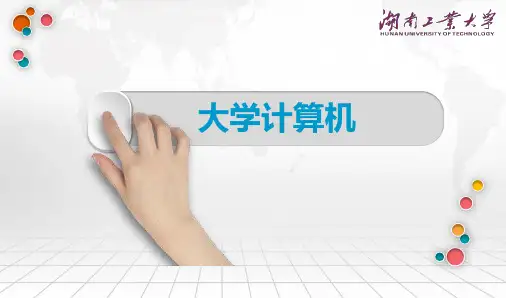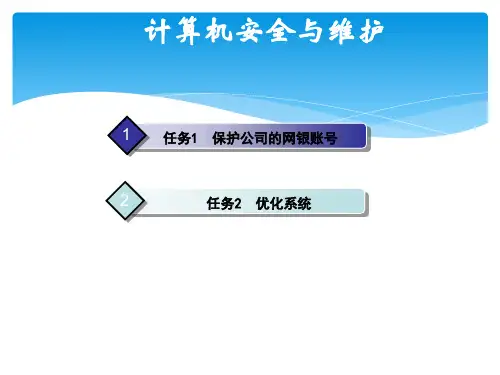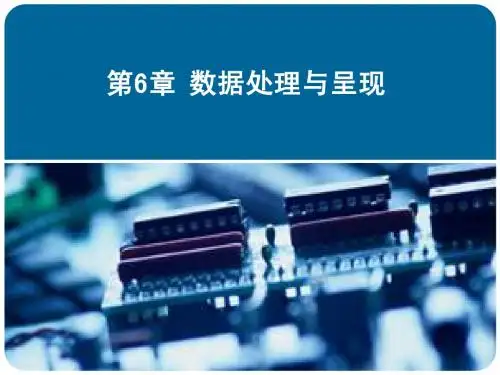915365-大学计算机基础第七版-第6章
- 格式:pptx
- 大小:2.10 MB
- 文档页数:12
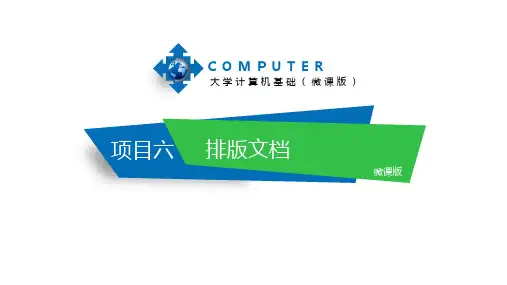
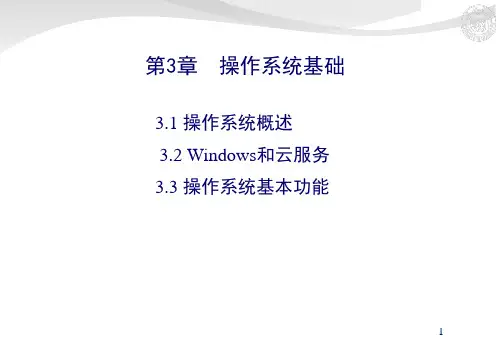
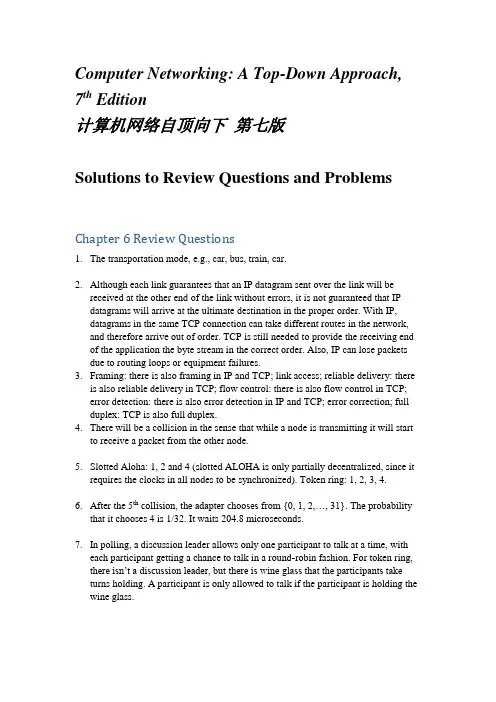
Computer Networking: A Top-Down Approach, 7th Edition计算机网络自顶向下第七版Solutions to Review Questions and ProblemsChapter 6 Review Questions1.The transportation mode, e.g., car, bus, train, car.2.Although each link guarantees that an IP datagram sent over the link will bereceived at the other end of the link without errors, it is not guaranteed that IP datagrams will arrive at the ultimate destination in the proper order. With IP,datagrams in the same TCP connection can take different routes in the network, and therefore arrive out of order. TCP is still needed to provide the receiving end of the application the byte stream in the correct order. Also, IP can lose packets due to routing loops or equipment failures.3.Framing: there is also framing in IP and TCP; link access; reliable delivery: thereis also reliable delivery in TCP; flow control: there is also flow control in TCP;error detection: there is also error detection in IP and TCP; error correction; full duplex: TCP is also full duplex.4.There will be a collision in the sense that while a node is transmitting it will startto receive a packet from the other node.5.Slotted Aloha: 1, 2 and 4 (slotted ALOHA is only partially decentralized, since itrequires the clocks in all nodes to be synchronized). Token ring: 1, 2, 3, 4.6.After the 5th collision, the adapter chooses from {0, 1, 2,…, 31}. The probabilitythat it chooses 4 is 1/32. It waits 204.8 microseconds.7.In polling, a discussion leader allows only one participant to talk at a time, witheach participant getting a chance to talk in a round-robin fashion. For token ring, there isn’t a discussion leader, but there is wine glass that the participants take turns holding. A participant is only allowed to talk if the participant is holding the wine glass.8.When a node transmits a frame, the node has to wait for the frame to propagatearound the entire ring before the node can release the token. Thus, if L/R is small as compared to t prop, then the protocol will be inefficient.9.248 MAC addresses; 232 IPv4 addresses; 2128 IPv6 addresses.10.C’s adapter will process the frames, but the adapter will not pass the datagrams upthe protocol stack. If the LAN broadcast address is used, then C’s adapter will both process the frames and pass the datagrams up the protocol stack.11.An ARP query is sent in a broadcast frame because the querying host does notwhich adapter address corresponds to the IP address in question. For the response, the sending node knows the adapter address to which the response should be sent, so there is no need to send a broadcast frame (which would have to be processed by all the other nodes on the LAN).12.No it is not possible. Each LAN has its own distinct set of adapters attached to it,with each adapter having a unique LAN address.13.The three Ethernet technologies have identical frame structures.14.2 (the internal subnet and the external internet)15.In 802.1Q there is a 12- bit VLAN identifier. Thus 212 = 4,096 VLANs can besupported.16.We can string the N switches together. The first and last switch would use oneport for trunking; the middle N-2 switches would use two ports. So the totalnumber of ports is 2+ 2(N-2) = 2N-2 ports.Chapter 6 ProblemsProblem 11 1 1 0 10 1 1 0 01 0 0 1 01 1 0 1 11 1 0 0 0Problem 2Suppose we begin with the initial two-dimensional parity matrix:0 0 0 01 1 1 10 1 0 11 0 1 0With a bit error in row 2, column 3, the parity of row 2 and column 3 is now wrong in the matrix below:0 0 0 01 1 0 10 1 0 11 0 1 0Now suppose there is a bit error in row 2, column 2 and column 3. The parity of row 2 is now correct! The parity of columns 2 and 3 is wrong, but we can't detect in which rows the error occurred!0 0 0 01 0 0 10 1 0 11 0 1 0The above example shows that a double bit error can be detected (if not corrected).Problem 301001100 01101001+ 01101110 01101011------------------------------10111010 11010100+ 00100000 01001100------------------------------11011011 00100000+ 01100001 01111001-----------------------------00111100 10011010 (overflow, then wrap around)+ 01100101 01110010------------------------------10100010 00001100The one's complement of the sum is 01011101 11110011Problem 4a)To compute the Internet checksum, we add up the values at 16-bit quantities:00000001 0000001000000011 0000010000000101 0000011000000111 0000100000001001 00001010-------------------------00011001 00011110The one's complement of the sum is 11100110 11100001.b)To compute the Internet checksum, we add up the values at 16-bit quantities: 01000010 0100001101000100 0100010101000110 0100011101001000 0100100101001010 01001011-------------------------10011111 10100100The one's complement of the sum is 01100000 01011011c)To compute the Internet checksum, we add up the values at 16-bit quantities: 01100010 0110001101100100 0110010101100110 0110011101101000 0110100101101010 01101011-------------------------00000000 00000101The one's complement of the sum is 11111111 11111010.Problem 5If we divide 10011 into 1010101010 0000, we get 1011011100, with a remainder of R=0100. Note that, G=10011 is CRC-4-ITU standard.Problem 6a) we get 1000110000, with a remainder of R=0000.b) we get 010*******, with a remainder of R=1111.c) we get 1011010111, with a remainder of R=1001.Problem 7a) Without loss of generality, suppose ith bit is flipped, where 0<= i <= d+r-1 and assume that the least significant bit is 0th bit.A single bit error means that the received data is K=D*2r XOR R + 2i. It is clear that if we divide K by G, then the reminder is not zero. In general, if G contains at least two 1’s, then a single bit error can always be detected.b) The key insight here is that G can be divided by 11 (binary number), but any number of odd-number of 1’s cannot be divided by 11. Thus, a sequence (not necessarily contiguous) of odd-number bit errors cannot be divided by 11, thus it cannot be divided by G.Problem 8a)1)1()(--=N p Np p E21)1)(1()1()('------=N N p N Np p N p E))1()1(()1(2----=-N p p p N NN p p E 1*0)('=⇒=b)N N N N N N p E N N N 11)11()11()11(1*)(11--=-=-=-- 1)11(lim =-∞→N N e N N N 1)11(lim =-∞→ Thuse p E N 1*)(lim =∞→Problem 9)1(2)1()(--=N p Np p E)3(2)2(2)1)(1(2)1()('------=N N p N Np p N p E))1(2)1(()1()3(2----=-N p p p N N121*0)('-=⇒=N p p E)1(2)1211(12*)(----=N N N N p E e e p E N 21121*)(lim =⋅=∞→Problem 10a) A’s average throughput is given by pA(1-pB).Total efficiency is pA(1-pB) + pB(1-pA).b) A’s throughput is pA(1-pB)=2pB(1-pB)= 2pB- 2(pB)2.B’s throughput is pB(1-pA)=pB(1-2pB)= pB- 2(pB)2.Clearly, A’s throughput is not twice as large as B’s.In order to make pA(1-pB)= 2 pB(1-pA), we need that pA= 2 – (pA / pB).c)A’s throughput is 2p(1-p)N-1, and any other node has throughput p(1-p)N-2(1-2p).Problem 11a)(1 – p(A))4 p(A)where, p(A) = probability that A succeeds in a slotp(A) = p(A transmits and B does not and C does not and D does not)= p(A transmits) p(B does not transmit) p(C does not transmit) p(D does not transmit)= p(1 – p) (1 – p)(1-p) = p(1 – p)3Hence, p(A succeeds for first time in slot 5)= (1 – p(A))4 p(A) = (1 – p(1 – p)3)4 p(1 – p)3b)p(A succeeds in slot 4) = p(1-p)3p(B succeeds in slot 4) = p(1-p)3p(C succeeds in slot 4) = p(1-p)3p(D succeeds in slot 4) = p(1-p)3p(either A or B or C or D succeeds in slot 4) = 4 p(1-p)3(because these events are mutually exclusive)c)p(some node succeeds in a slot) = 4 p(1-p)3p(no node succeeds in a slot) = 1 - 4 p(1-p)3Hence, p(first success occurs in slot 3) = p(no node succeeds in first 2 slots) p(some node succeeds in 3rd slot) = (1 - 4 p(1-p)3)2 4 p(1-p)3d)efficiency = p(success in a slot) =4 p(1-p)3Problem 12Problem 13The length of a polling round is)/(poll d R Q N +.The number of bits transmitted in a polling round is NQ . The maximum throughput therefore isQR d R d R Q N NQ poll poll +=+1)/( Problem 14a), b) See figure below.c)1. Forwarding table in E determines that the datagram should be routed to interface 192.168.3.002.2. The adapter in E creates and Ethernet packet with Ethernet destination address 88-88-88-88-88-88.3. Router 2 receives the packet and extracts the datagram. The forwarding table in this router indicates that the datagram is to be routed to 198.162.2.002.4.Router 2 then sends the Ethernet packet with the destination address of 33-33-33-33-33-33 and source address of 55-55-55-55-55-55 via its interface with IP address of 198.162.2.003.5.The process continues until the packet has reached Host B.a)ARP in E must now determine the MAC address of 198.162.3.002. Host E sendsout an ARP query packet within a broadcast Ethernet frame. Router 2 receives the query packet and sends to Host E an ARP response packet. This ARP response packet is carried by an Ethernet frame with Ethernet destination address 77-77-77-77-77-77.Problem 15a)No. E can check the subnet prefix of Host F’s IP address, and then learn that F ison the same LAN. Thus, E will not send the packet to the default router R1. Ethernet frame from E to F:Source IP = E’s IP addressDestination IP = F’s IP addressSource MAC = E’s MAC addressDestination MAC = F’s MAC addressb)No, because they are not on the same LAN. E can find this out by checking B’s IPaddress.Ethernet frame from E to R1:Source IP = E’s IP addressDestination IP = B’s IP addressSource MAC = E’s MAC addressDestination MAC = The MAC address of R1’s interface connecting to Subnet 3.c)Switch S1 will broadcast the Ethernet frame via both its interfaces as the receivedARP frame’s destination address is a broadcast address. And it learns that Aresides on Subnet 1 which is connected to S1 at the interface connecting to Subnet1. And, S1 will update its forwarding table to include an entry for Host A.Yes, router R1 also receives this ARP request message, but R1 won’t forward the message to Subnet 3.B won’t send ARP query message asking for A’s MAC address, as this address can be obtained from A’s query message.Once switch S1 receives B’s response message, it will add an entry for host B in its forwarding table, and then drop the received frame as destination host A is on the same interface as host B (i.e., A and B are on the same LAN segment).Lets call the switch between subnets 2 and 3 S2. That is, router R1 between subnets 2 and 3 is now replaced with switch S2.a) No. E can check the subnet prefix of Host F’s IP address, and then learn that F is on the same LAN segment. Thus, E will not send the packet to S2. Ethernet frame from E to F: Source IP = E’s IP address Destination IP = F’s IP address Source MAC = E’s MAC addressDestination MAC = F’s MAC addressb) Yes, because E would like to find B’s MAC address. In this case, E will send an ARP query packet with destination MAC address being the broadcast address. This query packet will be re-broadcast by switch 1, and eventually received by Host B. Ethernet frame from E to S2: Source IP = E’s IP address Destination IP = B’s IP address Source MAC = E’s MAC addressDestination MAC = broadcast MAC address: FF-FF-FF-FF-FF-FF.c) Switch S1 will broadcast the Ethernet frame via both its interfaces as the received ARP frame’s destination address is a broadcast address. And it learns that Aresides on Subnet 1 which is connected to S1 at the interface connecting to Subnet 1. And, S1 will update its forwarding table to include an entry for Host A.Yes, router S2 also receives this ARP request message, and S2 will broadcast this query packet to all its interfaces.B won’t send ARP query message asking for A’s MAC address, as this address can be obtained from A’s query message.Once switc h S1 receives B’s response message, it will add an entry for host B in its forwarding table, and then drop the received frame as destination host A is on the same interface as host B (i.e., A and B are on the same LAN segment).Problem 17Wait for 51,200 bit times. For 10 Mbps, this wait is12.51010102.5163=⨯⨯bps bitsmsecFor 100 Mbps, the wait is 512 μsec.At 0=t A transmits. At 576=t , A would finish transmitting. In the worst case, B begins transmitting at time t=324, which is the time right before the first bit of A’s frame arrives at B. At time t=324+325=649 B 's first bit arrives at A . Because 649> 576, A finishes transmitting before it detects that B has transmitted. So A incorrectly thinks that its frame was successfully transmitted without a collision.Problem 19Because A 's retransmission reaches B before B 's scheduled retransmission time (805+96), B refrains from transmitting while A retransmits. Thus A and B do not collide. Thus the factor 512 appearing in the exponential backoff algorithm is sufficiently large.Problem 20a) Let Y be a random variable denoting the number of slots until a success:1)1()(--==m m Y P ββ,where β is the probability of a success.This is a geometric distribution, which has mean β/1. The number of consecutive wasted slots is 1-=Y X thatββ-=-==11][][Y E X E x1)1(--=N p Np β11)1()1(1-----=N N p Np p Np xefficiency11)1()1(1-----+=+=N N p Np p Np k kxk kb)Maximizing efficiency is equivalent to minimizing x , which is equivalent tomaximizing β. We know from the text that β is maximized at Np 1=.c)efficiency 11)11()11(1-----+=N N NN k k∞→N lim efficiency 1/1/11-+=-+=e k kee k kd) Clearly, 1-+e k kapproaches 1 as ∞→k .Problem 21i) from A to left router: Source MAC address: 00-00-00-00-00-00Destination MAC address: 22-22-22-22-22-22Source IP: 111.111.111.001Destination IP: 133.333.333.003ii) from the left router to the right router: Source MAC address: 33-33-33-33-33-33Destination MAC address: 55-55-55-55-55-55Source IP: 111.111.111.001Destination IP: 133.333.333.003iii) from the right router to F: Source MAC address: 88-88-88-88-88-88Destination MAC address: 99-99-99-99-99-99Source IP: 111.111.111.001Destination IP: 133.333.333.003Problem 22i) from A to switch: Source MAC address: 00-00-00-00-00-00Destination MAC address: 55-55-55-55-55-55Source IP: 111.111.111.001Destination IP: 133.333.333.003ii) from switch to right router: Source MAC address: 00-00-00-00-00-00Destination MAC address: 55-55-55-55-55-55Source IP: 111.111.111.001Destination IP: 133.333.333.003iii) from right router to F: Source MAC address: 88-88-88-88-88-88Destination MAC address: 99-99-99-99-99-99Source IP: 111.111.111.001Destination IP: 133.333.333.003111.111.111.00311-11-11-11-11-11122.222.222.00466-66-66-66-66Problem 23If all the 11=9+2 nodes send out data at the maximum possible rate of 100 Mbps, a total aggregate throughput of 11*100 = 1100 Mbps is possible.Problem 24Each departmental hub is a single collision domain that can have a maximum throughput of 100 Mbps. The links connecting the web server and the mail server has a maximum throughput of 100 Mbps. Hence, if the three collision domains and the web server and mail server send out data at their maximum possible rates of 100 Mbps each, a maximum total aggregate throughput of 500 Mbps can be achieved among the 11 end systems.Problem 25All of the 11 end systems will lie in the same collision domain. In this case, the maximum total aggregate throughput of 100 Mbps is possible among the 11 end sytems. Problem 26Problem 27a) The time required to fill 8⋅L bits is.sec 16sec 1012883m LL =⨯⋅b) For ,500,1=L the packetization delay is.sec 75.93sec 161500m m =For ,50=L the packetization delay is.sec 125.3sec 1650m m =c) Store-and-forward delay RL 408+⋅=For 500,1=L , the delay issec 4.19sec 1062240815006μ≈⨯+⋅For ,50=L store-and-forward delay sec 1μ<.d) Store-and-forward delay is small for both cases for typical link speeds. However, packetization delay for 1500=L is too large for real-time voice applications.Problem 28The IP addresses for those three computers (from left to right) in EE department are: 111.111.1.1, 111.111.1.2, 111.111.1.3. The subnet mask is 111.111.1/24.The IP addresses for those three computers (from left to right) in CS department are: 111.111.2.1, 111.111.2.2, 111.111.2.3. The subnet mask is 111.111.2/24.The router’s interface card that connects to port 1 can be configured to contain two sub-interface IP addresses: 111.111.1.0 and 111.111.2.0. The first one is for the subnet of EE department, and the second one is for the subnet of CS department. Each IP address is associated with a VLAN ID. Suppose 111.111.1.0 is associated with VLAN 11, and 111.111.2.0 is associated with VLAN 12. This means that each frame that comes from subnet 111.111.1/24 will be added an 802.1q tag with VLAN ID 11, and each frame that comes from 111.111.2/24 will be added an 802.1q tag with VLAN ID 12. Suppose that host A in EE department with IP address 111.111.1.1 would like to send an IP datagram to host B (111.111.2.1) in CS department. Host A first encapsulates the IP datagram (destined to 111.111.2.1) into a frame with a destination MAC address equal to the MAC address of the router’s interface card that connects to port 1 of the switch. Once the router receives the frame, then it passes it up to IP layer, which decides that the IP datagram should be forwarded to subnet 111.111.2/24 via sub-interface 111.111.2.0. Then the router encapsulates the IP datagram into a frame and sends it to port 1. Note that this frame has an 802.1q tag VLAN ID 12. Once the switch receives the frame port 1, it knows that this frame is destined to VLAN with ID 12, so the switch will send the frame to Host B which is in CS department. Once Host B receives this frame, it will remove the 802.1q tag.Problem 30(The following description is short, but contains all major key steps and key protocols involved.)Your computer first uses DHCP to obtain an IP address. You computer first creates a special IP datagram destined to 255.255.255.255 in the DHCP server discovery step, and puts it in a Ethernet frame and broadcast it in the Ethernet. Then following the steps in the DHCP protocol, you computer is able to get an IP address with a given lease time.A DHCP server on the Ethernet also gives your computer a list of IP addresses of first-hop routers, the subnet mask of the subnet where your computer resides, and the addresses of local DNS servers (if they exist).Since your computer’s ARP cache is initially empty, your computer will use ARP protocol to get the MAC addresses of the first-hop router and the local DNS server.Your computer first will get the IP address of the Web page you would like to download. If the local DNS server does not have the IP address, then your computer will use DNS protocol to find the IP address of the Web page.Once your computer has the IP address of the Web page, then it will send out the HTTP request via the first-hop router if the Web page does not reside in a local Web server. The HTTP request message will be segmented and encapsulated into TCP packets, and then further encapsulated into IP packets, and finally encapsulated into Ethernet frames. Your computer sends the Ethernet frames destined to the first-hop router. Once the router receives the frames, it passes them up into IP layer, checks its routing table, and then sends the packets to the right interface out of all of its interfaces.Then your IP packets will be routed through the Internet until they reach the Web server. The server hosting the Web page will send back the Web page to your computer via HTTP response messages. Those messages will be encapsulated into TCP packets and then further into IP packets. Those IP packets follow IP routes and finally reach yourfirst-hop router, and then the router will forward those IP packets to your computer by encapsulating them into Ethernet frames.Problem 32a) Each flow evenly shares a link’s capacity with other flows traversing that link, then the 80 flows crossing the B to access-router 10 Gbps links (as well as the access router to border router links) will each only receive 10 Gbps / 80 = 125 Mbpsb) In Topology of Figure 5.31, there are four distinct paths between the first and third tier-2 switches, together providing 40 Gbps for the traffic from racks 1-4 to racks 9-12. Similarly, there are four links between second and fourth tier-2 switches, together providing 40 Gbps for the traffic from racks 5-8 to 13-16. Thus the total aggregate bandwidth is 80 Gbps, and the value per flow rate is 1 Gbps.c) Now 20 flows will need to share each 1 Gbps bandwidth between pairs of TOR switches. So the host-to-host bit rate will be 0.5 Gbps.Problem 33a)Both email and video application uses the fourth rack for 0.1 percent of the time.b)Probability that both applications need fourth rack is 0.001*0.001 = 10-6.c)Suppose the first three racks are for video, the next rack is a shared rack for bothvideo and email, and the next three racks are for email. Let's assume that thefourth rack has all the data and software needed for both the email and video applications. With the topology of Figure 5.31, both applications will have enough intra-bandwidth as long as both are not simultaneously using the fourth rack.From part b, both are using the fourth rack for no more than .00001 % of time, which is within the .0001% requirement.。
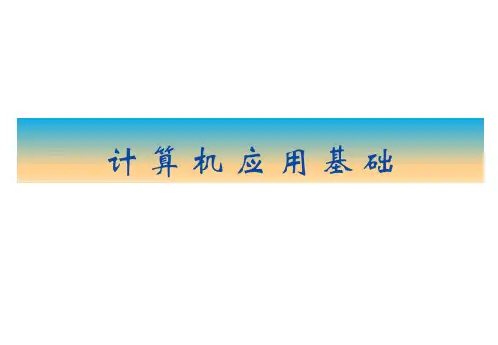

AlphaGoAlphaGo(阿尔法围棋)是第一个击败人类职业围棋选手、第一个战胜围棋世界冠军的人工智能程序,由谷歌(Google)旗下DeepMind公司戴密斯•哈萨比斯领衔的团队开发。
其主要工作原理是“深度学习”。
2016年3月,阿尔法围棋与围棋世界冠军、职业九段棋手李世石进行围棋人机大战,以4比1的总比分获胜;2016年末2017年初,该程序在中国棋类网站上以“大师”(Master)为注册帐号与中日韩数十位围棋高手进行快棋对决,连续60局无一败绩;2017年5月,在中国乌镇围棋峰会上,它与排名世界第一的世界围棋冠军柯洁对战,以3比0的总比分获胜。
围棋界公认阿尔法围棋的棋力已经超过人类职业围棋顶尖水平,在GoRatings网站公布的世界职业围棋排名中,其等级分曾超过排名人类第一的棋手柯洁。
2017年5月27日,在柯洁与阿尔法围棋的人机大战之后,阿尔法围棋团队宣布阿尔法围棋将不再参加围棋比赛。
2017年7月18日,教育部、国家语委在北京发布《中国语言生活状况报告(2017)》,阿尔法围棋入选2016年度中国媒体十大新词。
1. 工作原理——深度学习阿尔法围棋(AlphaGo)是一款围棋人工智能程序。
其主要工作原理是“深度学习”。
“深度学习”是指多层的人工神经网络和训练它的方法。
一层神经网络会把大量矩阵数字作为输入,通过非线性激活方法取权重,再产生另一个数据集合作为输出。
这就像生物神经大脑的工作机理一样,通过合适的矩阵数量,多层组织链接一起,形成神经网络“大脑”进行精准复杂的处理,就像人们识别物体标注图片一样。
阿尔法围棋用到了很多新技术,如神经网络、深度学习、蒙特卡洛树搜索法等,使其实力有了实质性飞跃。
美国脸书公司“黑暗森林”围棋软件的开发者田渊栋在网上发表分析文章说,阿尔法围棋系统主要由几个部分组成:一、策略网络(Policy Network),给定当前局面,预测并采样下一步的走棋;二、快速走子(Fast rollout),目标和策略网络一样,但在适当牺牲走棋质量的条件下,速度要比策略网络快1000倍;三、价值网络(Value Network),给定当前局面,估计是白胜概率大还是黑胜概率大;四、蒙特卡洛树搜索(Monte Carlo Tree Search),把以上这三个部分连起来,形成一个完整的系统。
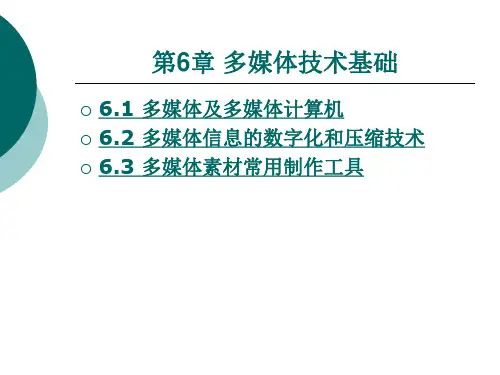
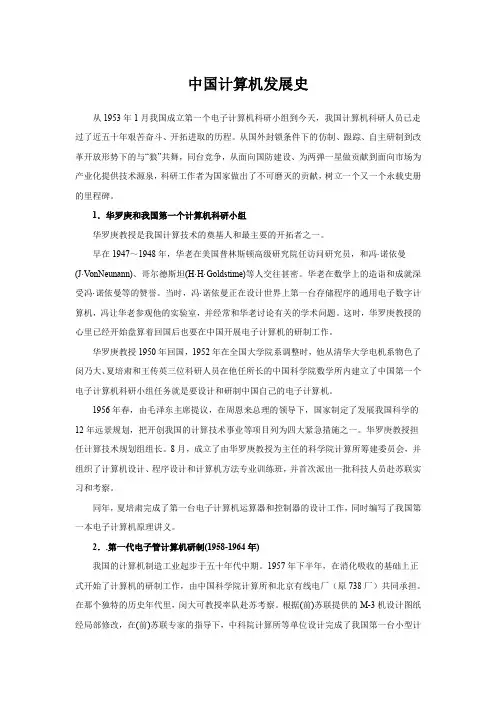
中国计算机发展史从1953年1月我国成立第一个电子计算机科研小组到今天,我国计算机科研人员已走过了近五十年艰苦奋斗、开拓进取的历程。
从国外封锁条件下的仿制、跟踪、自主研制到改革开放形势下的与“狼”共舞,同台竞争,从面向国防建设、为两弹一星做贡献到面向市场为产业化提供技术源泉,科研工作者为国家做出了不可磨灭的贡献,树立一个又一个永载史册的里程碑。
1.华罗庚和我国第一个计算机科研小组华罗庚教授是我国计算技术的奠基人和最主要的开拓者之一。
早在1947~1948年,华老在美国普林斯顿高级研究院任访问研究员,和冯·诺依曼(J·VonNeunann)、哥尔德斯坦(H·H·Goldstime)等人交往甚密。
华老在数学上的造诣和成就深受冯·诺依曼等的赞誉。
当时,冯·诺依曼正在设计世界上第一台存储程序的通用电子数字计算机,冯让华老参观他的实验室,并经常和华老讨论有关的学术问题。
这时,华罗庚教授的心里已经开始盘算着回国后也要在中国开展电子计算机的研制工作。
华罗庚教授1950年回国,1952年在全国大学院系调整时,他从清华大学电机系物色了闵乃大、夏培肃和王传英三位科研人员在他任所长的中国科学院数学所内建立了中国第一个电子计算机科研小组任务就是要设计和研制中国自己的电子计算机。
1956年春,由毛泽东主席提议,在周恩来总理的领导下,国家制定了发展我国科学的12年远景规划,把开创我国的计算技术事业等项目列为四大紧急措施之一。
华罗庚教授担任计算技术规划组组长。
8月,成立了由华罗庚教授为主任的科学院计算所筹建委员会,并组织了计算机设计、程序设计和计算机方法专业训练班,并首次派出一批科技人员赴苏联实习和考察。
同年,夏培肃完成了第一台电子计算机运算器和控制器的设计工作,同时编写了我国第一本电子计算机原理讲义。
2..第一代电子管计算机研制(1958-1964年)我国的计算机制造工业起步于五十年代中期。
